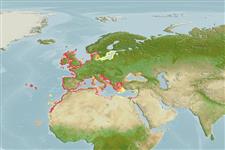Common names from other countries
Environment: milieu / climate zone / depth range / distribution range
Ecologia
marinhas; Água doce; estuarina; catádromo (Ref. 59043); intervalo de profundidade 10 - 20 m (Ref. 30578). Temperate; 60°N - 15°N, 32°W - 42°E
Eastern Atlantic: from the coasts of southern Norway to Cape Verde, including the Mediterranean and the Black Sea (Ref. 2804, Ref. 51442, 116118). Records of its occurrence in tropical waters are based on misidentifications (Ref. 3573).
Comprimento de primeira maturação / Tamanho / Peso / Idade
Maturity: Lm 25.9, range 25 - 32 cm
Max length : 70.0 cm TL macho/indeterminado; (Ref. 4645); common length : 35.0 cm TL macho/indeterminado; (Ref. 3646); peso máx. publicado: 2.9 kg (Ref. 40476); idade máx. registrada: 10 anos (Ref. 40476)
Espinhos dorsais (total) : 4 - 5; Raios dorsais (total) : 7 - 10; Espinhos anais: 3; Raios anais : 8 - 9. Fusiform body (Ref. 51442). Massive head, flattened above the eyes (Ref. 51442). Small mouth (Ref. 51442). Snout short and blunt (Ref. 51442). Two dorsal fins well-separated, the first with 4 to 5 spines (Ref. 40476, Ref. 51442). Pectoral fins are placed high on the flanks (Ref. 51442). Large scales (Ref. 51442). Dorsal sides and flanks gray-colored, ventral side white (Ref. 51442).
Adults are pelagic occurring near shore, entering lagoons and lower reaches of rivers in schools; often in polluted waters (Ref. 51442, 59043) between temperatures 8-24°C. Juveniles colonize the littoral zone and estuaries (Ref. 51442). Adults feed on epiphytic algae, detritus and small benthic or planktonic organisms, pelagic eggs and larvae while juveniles feed on zooplankton until about 3.0 cm SL, then on benthic animals and plants (Ref. 59043). Spawning takes place at sea near the coast between September and February (Ref. 30578, 51442). Oviparous, eggs are pelagic and non-adhesive (Ref. 205). Adults undergo migrations (Ref. 51442).
Spawning takes place at sea near the coast by gathering in groups between September and February (Ref. 51442). The eggs develop at sea (Ref. 51442). The juveniles then colonize the littoral zone and the estuaries (Ref. 51442). Adults enter the lower parts of the rivers and treturn to the sea to spawn (Ref. 51442).
Thomson, J.M., 1990. Mugilidae. p. 855-859. In J.C. Quero, J.C. Hureau, C. Karrer, A. Post and L. Saldanha (eds.) Check-list of the fishes of the eastern tropical Atlantic (CLOFETA). JNICT, Lisbon; SEI, Paris; and UNESCO, Paris. Vol. 2. (Ref. 7399)
Status na Lista Vermelha da UICN (Ref. 130435)
CITES (Ref. 128078)
Not Evaluated
Ameaça para os humanos
Harmless
Uso pelos humanos
Pescarias: espécies comerciais; Aquacultura: espécies comerciais; peixe esportivo: sim
Ferramentas
Relatórios especiais
Baixar XML
Fontes da internet
Estimates based on models
Preferred temperature (Ref.
115969): 9.7 - 20.1, mean 11.8 (based on 314 cells).
Índice de diversidade filogenética (Ref.
82804): PD
50 = 0.5005 [Uniqueness, from 0.5 = low to 2.0 = high].
Bayesian length-weight: a=0.00933 (0.00743 - 0.01172), b=2.96 (2.93 - 2.99), in cm Total Length, based on LWR estimates for this species (Ref.
93245).
Nível Trófico (Ref.
69278): 2.3 ±0.20 se; based on food items.
Resiliência (Ref.
120179): Baixo, tempo mínimo de duplicação da população 4,5 - 14 anos (K=0.15; tm=3-5).
Fishing Vulnerability (Ref.
59153): Moderate vulnerability (42 of 100).
